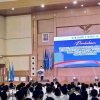Surabaya, Indonesia --- Five talented students from SMP Islam Al Azhar 13 Surabaya have successfully developed the E-Helmet (Electronic Helmet for Enhanced Location, Monitoring, Emergency, and Tracking), a solar-powered smart helmet designed to enhance rider safety and promote eco-friendly urban transportation. The innovative team, consisting of Felio Altaf Prajatara, Muhammad Farzana Admawidya, Richie Medina Tarwoto, Zivara Rahmalika Alyadeena Maricar Sahib, and Daekenzie Ar Rayyan Adityawarman, combined renewable energy technology with advanced safety systems to create a multifunctional helmet for the future of sustainable mobility.
The E-Helmet integrates a photovoltaic solar panel positioned on the top surface to harvest solar energy and convert it into electricity. This energy is stored in a built-in lithium-ion battery, which powers the helmet's intelligent safety features, such as a mobile charging port, drowsiness alert system, proximity sensors, and GPS navigation. "Our E-Helmet is not just about protection---it's about awareness, sustainability, and smarter riding," explained team leader Felio Altaf. "We want to help riders stay safe while reducing dependence on conventional power sources."

Designed to support both safety and convenience, the E-Helmet features a solar-powered charging port that allows riders to charge their smartphones or navigation devices while on the move. The drowsiness detection system identifies signs of fatigue and sends gentle vibrations to keep the rider alert, while the proximity sensor emits an audible warning when vehicles or obstacles come too close. Through its Bluetooth and GPS integration, the helmet also enables location tracking and navigation support in real-time, providing a connected and secure riding experience.
The E-Helmet project aims to address the growing challenges of urban mobility and road safety, particularly in cities where traffic congestion and driver fatigue contribute to frequent accidents. By harnessing renewable solar energy, the E-Helmet not only enhances rider safety but also supports environmental sustainability, reducing dependence on fossil fuels and contributing to lower carbon emissions.

The research and development were carried out at SMP Islam Al Azhar 13 Surabaya between June and September 2025. The team used an IMU sensor (MPU6050) to detect head movement and balance, an ESP32 microcontroller to process data, and ultrasonic sensors (HC-SR08) to detect nearby objects. The system was connected through a solar charge controller to manage power flow efficiently. Tests on the prototype showed that the helmet's systems operated effectively using stored solar energy, with rapid response times to detect drowsiness or potential collisions.
In conclusion, the E-Helmet stands as a remarkable example of how youth innovation can merge technology, sustainability, and safety into one impactful product. By utilizing solar energy to power essential safety systems, this invention not only promotes smarter and safer urban mobility but also contributes directly to several United Nations Sustainable Development Goals (SDGs), including SDG 3 (Good Health and Well-Being), SDG 7 (Affordable and Clean Energy), SDG 9 (Industry, Innovation, and Infrastructure), and SDG 11 (Sustainable Cities and Communities). The E-Helmet reflects a new generation's commitment to creating environmentally conscious solutions that protect lives, conserve energy, and build a cleaner, safer future for all.
Follow Instagram @kompasianacom juga Tiktok @kompasiana biar nggak ketinggalan event seru komunitas dan tips dapat cuan dari Kompasiana. Baca juga cerita inspiratif langsung dari smartphone kamu dengan bergabung di WhatsApp Channel Kompasiana di SINI









